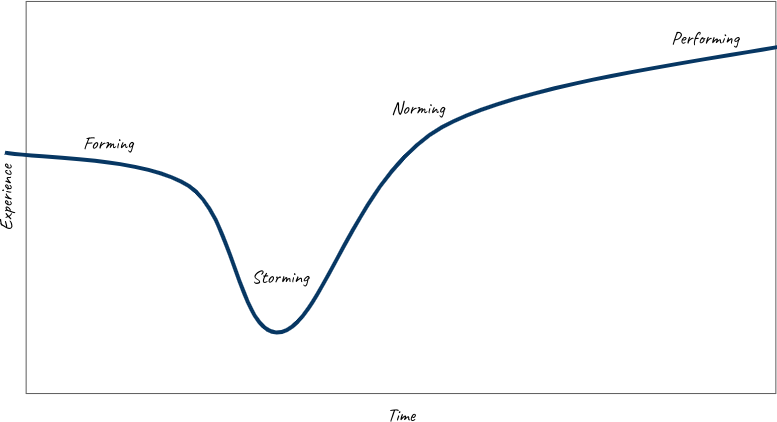 Forming, storming, norming, and performing
Forming, storming, norming, and performing
When bringing people together in a new team, most groups go through these four stages.
Group dynamics can be challenging for new leaders. On paper, it may be completely the right idea for people to work together in a group towards some common goal. But the reality can be quite different.
The four stages
When bringing people together in a new team, it's rare that things go completely smoothly. You'll likely hit some snags along the way, especially if you're bringing change to an organization. When creating a new team, most groups go through these four stages:
Forming: The group starts working together on a new project. The team members may know each other, or they may not. At this stage of the project, the group starts to make connections within the team. Depending on the personalities involved, groups may either view this stage with positivity or some degree of cautious optimism.
Storming: As the team starts to learn their roles and establish boundaries for the work, tensions rise. The work experience declines. In some change management models, this phase is also called the "Pit of Despair" because negativity breeds negativity; someone who is having difficulty adjusting to the change may try to bring others to their way of thinking.
Norming: After a time, the group settles into their new roles, and they begin to find ways to work together. Optimism in the project's success tends to rise in this phase.
Performing: The group pulls together and functions effectively as a team.

This model originates from American psychologist Bruce Tuckman (1965) and I find it is still true today. Tuckman proposed the phases and defined them, but I like to overlay these phases with the change management model to show how group dynamics and the overall experience interconnect.
Leadership strategies
Our role in leadership is to help our teams to work their way through the Storming phase as quickly as possible. It may not be possible to eliminate this awkward phase, but we can help to shorten its duration. Let's examine a few strategies:
Get buy-in. When launching any new effort, it's important to help those involved understand why we are making this change and how this will benefit us. This establishes buy-in to the project or change. If group members understand the end goal, and their role in making that delivery, they can find ways to work through the Storming phase with minimal disruption.
Build bridges. If you recognize that the group is approaching the Storming phase, you can try to build a bridge over it. One method is by establishing boundaries to help team members avoid bumps as they work out the "who does what" phase.
Create lines of communication. Groups can get on the same page more quickly if they can talk through issues. At the start of any new project, schedule regular "stand-up" meetings so group members have a forum to discuss issues and review progress. I recommend doing these at a predictable schedule, such as right away every morning, every workday.
Push/pull. If the organization has tackled a similar project in the past, leverage that past success by bringing in former team members. Allow them to share what they learned on their project, in an open and honest conversation. Discuss what went well and what didn't go smoothly, and follow up that conversation with a team exercise to identify changes they might make to avoid similar issues.
